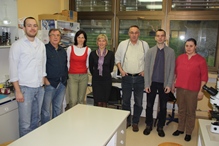Nonlinear component analysis with applications in chemometrics and pathology
- Croatian Science Foundation 9.01/302
Project leader
- Dr.sc. Ivica Kopriva, ZLAIR, IRB
Duration
- 12/1/2012 - 11/30/2015 (3 years)
Budget
- 997,599,70 KN
Researchers and consultants
- Dr.sc. Marijana Popović-Hadžija, ZMM, IRB
- Marko Filipović, dipl. inž, research assistant, ZLAIR, IRB
- Ante Jukić, dipl. inž, research assistant, ZLAIR, IRB
- Lidija Brkljačić, dipl. inž, research assistant, ZOKiB, IRB
- Dr.sc. Ivanka Jerić (consultant), ZOKiB, IRB
- Dr.sc. Mirko Hadžija (consultant), ZMM, IRB
- Dr.sc. Gorana Aralica (consultant), KBC Dubrava
- Prof. dr.sc. Šimun Križanac (consultant), KBC Dubrava
Project objectives
- Development and comparative analysis of methods for nonlinear blind source separation of sparse signals (NBSS), i.e. nonlinear sparse component analysis (NSCA). Source exctraction will be based on explicit and implicit mappings into reproducible kernel Hilbert space, that enables solution of the NBSS without structural constraints on nonlinearities. This makes the proposed concept practically important.
- Application od NBSS/NSCA in chemometrics for extraction of pure components (analytes) from nonlinear models of chemical reactions. The number of analytes is greater than the number of mixtures (underdetermined BSS). Chemical reactions will represent models of biologically important reactions: formation and hydrolysis of esters and formation of peptide connection. Extraction of analytes from mass spectra is important for disease diagnostics (biomarker identification), monitoring toxicity of xenobiotics, and response of living organisms on changes in nutrition and environment.
- Application of NBSS/NSCA in decomposition (segmentation) of multispectral image of histopathological sample into anatomically meaningful components, but without using contrast agens. Formulation of image segmentation in RKHS isused to increase the contrast between the objects (tissues) present in the image. Possible elimination of contrast agens is practically important for faster histological analysis and intraoperative tissue analysis.
unique visits:

